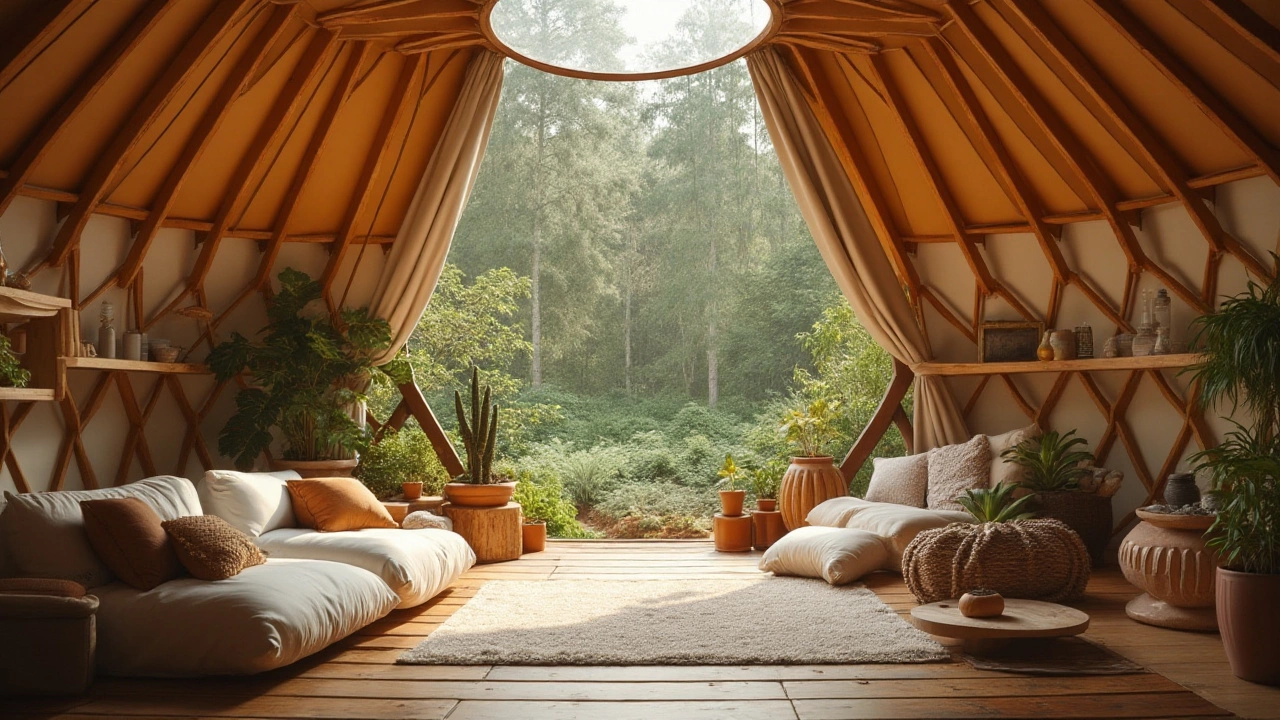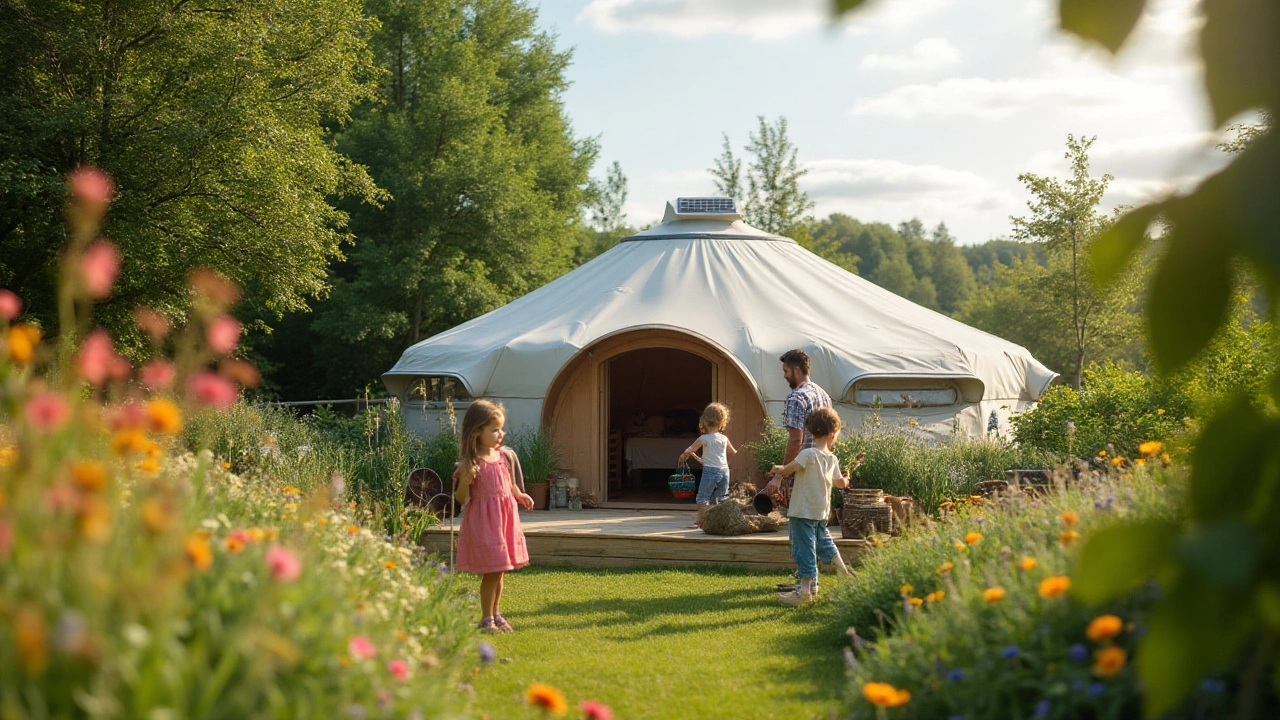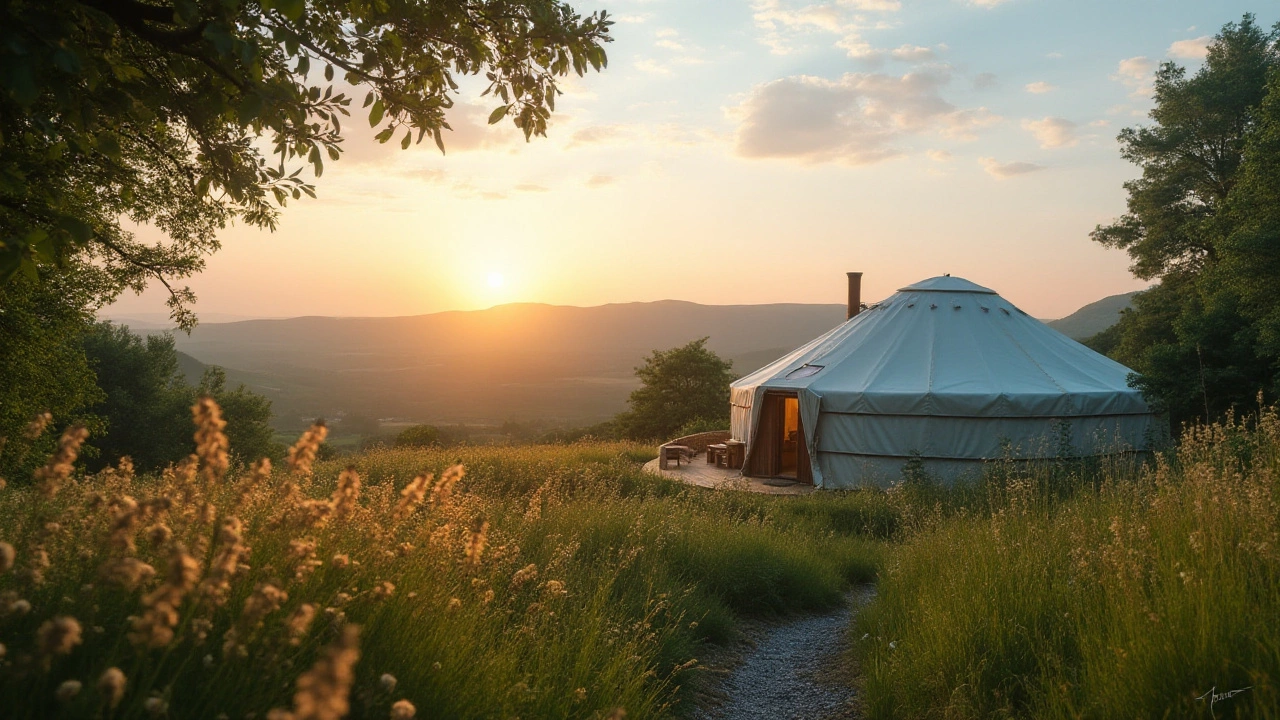In recent years, the appeal of yurts as eco-friendly homes has captivated the hearts of those yearning for a greener lifestyle. These circular, tent-like structures have been cherished by nomadic peoples for centuries and are now experiencing a renaissance among sustainability enthusiasts. A yurt's simplicity, combined with its deep connection to nature, speaks volumes about a lifestyle that values living harmoniously with our environment.
At the core of their eco-friendliness, yurts feature a fascinating blend of natural materials and efficient design. Whether set against majestic mountains or nestled in quiet woodlands, they offer a low-impact way of dwelling that aligns with the principles of sustainable living. From energy efficiency to sustainable design, let's explore what makes yurts an eco-friendly haven for modern-day explorers.
- A Brief History of Yurts
- Materials and Construction
- Energy Efficiency in Yurts
- Sustainable Living and Design
- Adapting Yurts for Modern Living
- Challenges and Considerations
A Brief History of Yurts
The history of yurts is rich and fascinating, stretching back over thousands of years. These ingenious shelters originate from the heart of Central Asia, where they served as the homes of nomadic tribes such as the Mongols. Their circular design is not only practical but deeply symbolic, symbolizing harmony and balance within the natural world. The ancient nomads who invented the yurt needed a home that was both portable and resilient, capable of withstanding harsh winds and extreme climates. The yurt fit that need perfectly, using a collapsible wood frame covered with felt or canvas to create a durable yet flexible structure. It allowed its inhabitants to move seasonally, following herds across the steppes with ease.
The word 'yurt' itself comes from the Turkic languages, translating roughly to 'homeland' or 'people.' It's a poignant reminder of the mobile lifestyle these ancient people led. As the Mongol Empire expanded, so did the influence of the yurt, reaching as far as Europe and the Middle East. The design has stood the test of time, adapting to numerous cultures over centuries. A testament to their enduring appeal, Marco Polo, in his travels, described the opulence of the Mongol's portable palaces constructed in the yurt style. They were not merely shelters but integral to the way of life, reflecting a balance with nature and simplicity in living.
Today, eco-friendly yurts have found a unique place in modern architecture and lifestyle. Their resurgence speaks to a growing desire for sustainable living options that minimize ecological footprints. The revival can be seen in various contexts: from off-the-grid residences to alternative tourism lodging. In some cases, yurts serve as an eco-conscious statement, promoting the ethos of living lightly on the earth. Their traditional design has been preserved, yet with improvements to make them suitable for contemporary living. Insulated walls, modern amenities, and innovative materials have given new life to this ancient dwelling, blending tradition with modern needs.
In an article by National Geographic, it was noted, "Yurts have been utilized for centuries due to their practical and environmental advantages, uniquely meeting the needs of countless generations of nomads.”
While the yurt’s essence remains unchanged, the way people perceive and use them has evolved significantly. The ability to connect with history while living sustainably is compelling. For those looking to escape the constraints of conventional living, yurts offer a simple but meaningful alternative. As we look to the past to inform our futures, these humble yet extraordinary structures remind us of the potential in sustainable and adaptable living, even in today’s rapidly changing world.
Materials and Construction
Delving into the world of yurts reveals a fascinating approach to sustainable architecture. Their construction is steeped in tradition, showcasing the ingenuity of ancient cultures who crafted these portable homes with precision. A typical yurt is comprised of a wooden frame, often constructed from lightweight and durable materials like willow or birch, and is then covered with layers of felt and canvas. This clever use of natural resources not only ensures durability but also acts as an effective insulator, keeping the inhabitants cozy and sheltered from the elements.
"The efficiency of yurts lies in their simplicity and the clever use of natural, sustainable materials," remarks architectural historian Dr. Emily Carter.
Modern eco-friendly homes enthusiasts have continued this legacy by incorporating even more sustainable materials into their construction. Bamboo has become a popular choice due to its rapid growth and minimal environmental impact. Additionally, the outer covering has seen innovations such as recycled canvas and eco-friendly waterproof coatings, ensuring that these structures remain sustainable without compromising on quality. The inherent flexibility of yurts allows for customization, enabling owners to tailor their spaces to specific climates and needs, thus enhancing their environmental friendliness.
In terms of construction, assembling a yurt can be a testament to community spirit and collaboration. The process often brings together family and friends, all working harmoniously to erect this circular dwelling. The simplicity of the design allows for quick assembly and disassembly, ideal for those wishing to minimize their environmental footprint. Interestingly, unlike contemporary housing, yurts require minimal excavation, allowing the ground to remain largely undisturbed and preserving local ecosystems. A closer look at the construction process underscores how adaptable this ancient design is, capable of withstanding varied climates while maintaining a minute impact on its surroundings.
It's also worth noting how efficiently a yurt uses space — the circular layout maximizes usable area while promoting a sense of community within the dwelling. The absence of interior walls enhances airflow and utilizes natural light effectively, reducing the need for artificial lighting during daylight hours. As interest in sustainable living continues to grow, yurts offer a tangible means of living more intimately with the environment, reminding us of the value simplicity can bring to modern life.

Energy Efficiency in Yurts
When it comes to embracing energy-efficient lifestyles, yurts stand out as unique structures. Their circular design not only creates a harmonious living space but also enhances thermal efficiency. The compact shape minimizes the surface area exposed to the elements, reducing energy loss significantly compared to traditional rectangular buildings. A well-insulated yurt can maintain a stable interior climate with minimum input from heating or cooling systems. Many enthusiasts appreciate this feature, noting how their utility bills stay pleasantly low year-round, particularly in regions with moderate climates.
The materials used in constructing yurts also contribute to their eco-friendly status. Historically, yurts were made from sheep's wool felt and wooden frames, which provided natural insulation. Today, modern yurts often incorporate sustainable materials like recycled denim insulation or sheep wool, which are not only effective but also environmentally responsible. These materials form a barrier that keeps the heat inside during winter and helps maintain cooler temperatures in summer. As a result, yurts often require less resource-intensive methods for temperature regulation, appealing greatly to those pursuing a lifestyle rooted in sustainable living.
The simple yet effective use of passive solar heating is another remarkable feature of yurts. By positioning the structure to capture the sun's warmth during winter months, owners can take full advantage of natural heating. Windows and skylights strategically placed help in absorbing sunlight, allowing natural light to penetrate deeply into the space. This design reduces reliance on artificial lighting and heating, further bolstering the yurt's energy efficiency. Incorporating reflective shades and ventilated spaces aids in maintaining cooler interiors in the hot months, demonstrating how clever design can harmonize with nature's rhythms.
"Yurts, by design, encourage people to reconnect with the Earth. They remind us how little energy we truly need when clever design is our ally," remarked eco-architect David Greyson in an interview with Green Living Journal.
Some yurt dwellers go a step further by integrating renewable energy systems. Solar panels mounted on or near yurts provide electricity for lighting and small appliances, while rainwater harvesting systems can meet water needs sustainably. These additions make yurts truly self-sufficient and highlight the innovative ways people are reducing their carbon footprints. It's clear that by embracing green architecture, yurt enthusiasts are not just adopting a housing style but are actively contributing to a more sustainable planet.
For those considering a yurt as a permanent or seasonal residence, understanding the nuances of energy efficiency is essential. Knowledge about insulation ratings, ventilation options, and sustainable material choices can make a significant difference in how effectively a yurt can be maintained. It's about embracing a lifestyle that not only respects nature but thrives within its boundaries, underlining the importance of making intentional choices about our impact on the planet. If one seeks a dwelling where simplicity and sustainability converge, yurts offer a compelling model to consider for green living in the modern world.
Sustainable Living and Design
Yurts, unique for their origins as the dwellings of Mongolian nomads, have transitioned into symbols of sustainable living and green architecture in our modern world. Despite their ancient roots, these structures have been ingeniously adapted to meet the demands of environmentally conscious living. The frame of a yurt is typically constructed from locally sourced wood, a renewable material, reducing the carbon footprint associated with transportation. The cover, often made of canvas or wool felt, provides effective insulation while being biodegradable. This choice of materials embodies the ethos of living lightly on the Earth.
One of the most alluring features of a yurt is its reduced energy requirements. The circular design promotes efficient air circulation, requiring less energy for heating and cooling. This natural airflow, coupled with the insulating properties of the thick felt or canvas walls, maintains a comfortable interior climate year-round. A well-insulated yurt can significantly minimize reliance on external heating sources, such as gas or electric systems, which is a substantial advantage in the quest to reduce energy consumption. Moreover, the simplicity of yurt construction encourages the use of passive solar design principles. For example, strategically placed windows and skylights can maximize natural light and heat from the sun, further reducing the need for artificial lighting and heating.
Adapting the green architecture of a yurt to include modern amenities does not have to compromise its sustainability. Eco-friendly technologies such as solar panels for electricity and composting toilets can easily be incorporated. A significant number of yurt owners opt for rainwater harvesting systems, making the most of natural resources to decrease their environmental impact and foster a self-sufficient lifestyle. The circular design even encourages mindfulness, contributing to a less cluttered lifestyle that emphasizes the essentials, which aligns perfectly with the principles of minimalism and sustainability.
"The modern yurt is a testament to returning to simple living, connecting us back to nature and the cycle of seasons," says Jane Goodall, renowned conservationist.
Living in a yurt also offers the benefit of mobility and adaptability, crucial aspects when considering sustainable habitats. Unlike a conventional home, a yurt can be disassembled with ease, reducing the need for new materials if relocation is required. This portability not only saves resources but also limits the environmental impact typical of constructing and demolishing traditional houses. Moreover, the minimal groundwork needed for a yurt setup helps preserve the natural landscape, allowing for a harmonious coexistence with the surrounding ecosystem. Given these factors, it's easy to see why a yurt has become an appealing model of eco-friendly housing.
Indeed, the yurt symbolizes a commitment to environmentally conscious living. By weaving together traditional design with modern sustainability principles, yurts create a rich tapestry that advocates for living in harmony with nature. As the world leans towards sustainable solutions, the lessons drawn from the simple yet profound design of these timeless dwellings cannot be underestimated. They encourage us to rethink the way we inhabit our planet, highlighting a pathway towards a more sustainable and connected existence.

Adapting Yurts for Modern Living
As more people turn towards sustainable lifestyles, yurts have evolved to meet the demands of modern living. While these traditional abodes have maintained their characteristic circular design and nomadic roots, innovations have seamlessly integrated contemporary comforts without sacrificing their eco-friendly benefits. Yurts today often come equipped with high-tech amenities like solar panels, composting toilets, and efficient insulation, allowing them to blend functionality with sustainability. Many companies now offer customizable yurts that can include features such as skylights and double-layered walls to enhance both comfort and energy efficiency.
One of the greatest attractions of adapting yurts to modern living is their incredible versatility. Contemporary yurts can function as anything from primary residences to vacation cabins or even as unique event spaces. The open layout seen in most yurt designs lends itself to creative interior solutions. Owners frequently incorporate movable partitions or curtains to define specific areas within the yurt, creating cozy sleeping nooks or functional workspace. This commitment to adaptability means that yurts can grow with their owners, transforming to meet their changing needs and lifestyles.
A notable aspect of modern yurts is their ability to minimize ecological footprints. By choosing sustainable building materials and incorporating passive solar techniques, yurts effectively reduce energy consumption. For instance, using natural wool for insulation or sourcing local, renewable wood for the structure has become commonplace. A
statement from sustainability expert Bill McKibben highlights this trend: "Yurts are a brilliant illustration of how simple structures can be fundamentally kind to the planet, showcasing our potential to live lightly and contentedly."
Despite their simplicity, yurts are not without their challenges when being adapted to a modern context. Regulatory barriers regarding permanent residency and building permits can vary widely, depending on local governing bodies. In addition, owners must be mindful of climate-specific considerations, such as bolstering structural resilience in regions prone to heavy snowfall or high winds. Choosing the right site is also essential; a well-positioned yurt maximizes environmental advantages such as natural lighting and cross-ventilation, yet it's vital to remain sensitive to any ecological impact on the surrounding environment.
In some cases, incorporating advanced sustainable technologies into yurts can be a smart move. These might include greywater systems that treat wastewater on-site, or off-grid energy solutions utilizing biofuel generators. Modern yurts can even be equipped with smart home features, providing inhabitants the ability to control their environment remotely, enhancing both security and energy efficiency. For those looking to preserve the ancient appeal of yurts while embracing what the future holds, these advancements present a harmonious blend of the past and the present.
Challenges and Considerations
Living in a yurt provides an enchanting connection to nature and a simpler lifestyle, but it also comes with a set of challenges that need careful consideration. One of the foremost concerns is climate suitability. Yurts, traditionally designed for moderate climates, may certainly require adaptations in areas with extreme weather conditions. Insulation becomes vital in colder regions to maintain a cozy interior, while ventilation must be adeptly managed in warmer climates to prevent overheating.
Another notable consideration is related to local zoning laws and building regulations. Not every location welcomes yurts as permanent dwellings, and potential homeowners may encounter legal hurdles. Ensuring compliance with local regulations is crucial, and this process can sometimes be unexpectedly complicated and time-consuming. It’s always beneficial to research local guidelines before embarking on a yurt journey. Not to mention, acquiring a building permit might be an uphill task where regulations are stringent.
Energy efficiency also poses a unique challenge. While yurts are celebrated for their minimalist approach, their circular shape can make fitting traditional heating systems or solar panels a bit tricky. Creative solutions are often needed to integrate modern amenities without sacrificing the eco-friendly nature that makes yurts special. One might look into alternative energy sources, such as portable solar kits, to bridge this gap.
Maintaining the structural integrity of a yurt is another consideration. These structures rely heavily on tension and compression, which means the materials used must be suited for long-term use. Canvas or fabric outer coverings, which can suffer from wear and tear due to harsh environmental conditions, might need periodic replacements or repairs. It's not uncommon for yurt owners to strengthen their frames to withstand high winds or heavy snowfall.
"Yurts offer a unique opportunity to marry sustainable living with affordability," advises Margaret Russell, an expert in sustainable architecture. "Yet, one must carefully assess their lifestyle needs against the unique limitations posed by a more unconventional home," she emphasizes.
Moreover, while yurts require less space, organizing the interior can be challenging. People often face difficulties when trying to fit standard furniture into a circular space. Custom furniture solutions or modular pieces that optimize the use of space without cluttering are popular among yurt enthusiasts. Keeping the interior functional whilst maintaining its aesthetic simplicity is a delicate balance and requires thoughtful planning.
Despite these hurdles, yurts continue to grow in popularity due to their affordability, flexibility, and low environmental impact. It’s crucial for prospective owners to weigh both the romantic ideals and practical realities they offer. Armed with research and ingenuity, the journey toward sustainable living in a yurt can be deeply rewarding, offering a harmonious balance with nature many long to achieve.
